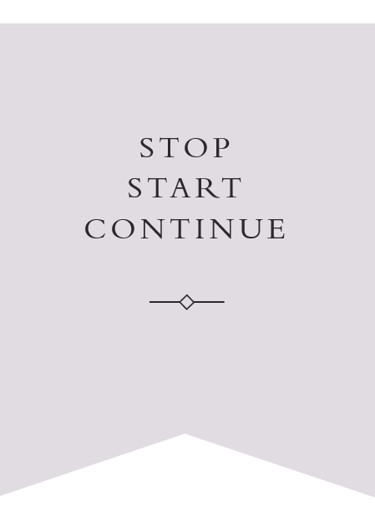Feedback: Stop, Start, Continue
Feedback is essential for growth but providing it effectively can be a challenge. "Stop, Start, Continue" provides a balanced structured way for participants to give and receive actionable feedback on behaviors, processes, or strategies. This versatile tool is used in everything from team development and project management to change management.
Mark Gedeon
10/21/20244 min read


Feedback: Stop, Start, Continue
Feedback is essential for growth but providing it effectively can be a challenge. "Stop, Start, Continue" provides a balanced structured way for participants to give and receive actionable feedback on behaviors, processes, or strategies. This versatile tool is used in everything from team development and project management to change management Here’s how it works:
Breaking Down "Stop, Start, Continue"
The "Stop, Start, Continue" method provides a clear and practical way to give feedback by focusing on three key areas:
Stop: Identify actions, behaviors, or processes that aren't effective or are hindering progress. It’s about recognizing what to cut; and preventing wasted effort and resources.
Start: Suggest new behaviors or strategies that could drive improvement. It’s about finding the gaps and addressing them with fresh approaches.
Continue: Highlight what's working well and should be maintained. Reinforcing positive practices ensures that successful habits stay consistent.
Why Use "Stop, Start, Continue"?
This method stands out because it’s:
Action-Oriented: Instead of vague feedback, it provides specific actions to take, making it easier to implement changes.
Inclusive: Encourages participation from all levels, fostering a culture of continuous improvement.
Balanced: Combines constructive criticism with positive reinforcement, ensuring feedback remains motivating rather than discouraging.
Simple and Clear: The structure keeps the focus on actionable insights, avoiding overwhelming suggestions.
Applying "Stop, Start, Continue" in Business Training
Here are some ways this feedback tool can be used across different contexts:
Team Development and Performance Reviews
In regular feedback sessions, this technique creates an open and transparent environment for discussing what should change and what should stay the same. It empowers teams to shape their own culture and performance standards.
For performance reviews, managers can provide employees with actionable feedback, making it clear what to stop doing, what new initiatives to undertake, and which strengths to continue leveraging. For instance, an employee might be encouraged to stop overloading emails with excessive detail (Stop), start using project management tools to track tasks more efficiently (Start), and continue their proactive communication with clients (Continue).
Project Management and Retrospectives
After a project concludes, using "Stop, Start, Continue" helps teams evaluate their processes and outcomes, making specific adjustments for future projects while reinforcing practices that led to success.
Example: A project team might decide to stop using manual time tracking (Stop), start implementing weekly status updates to keep everyone informed (Start), and continue maintaining their clear documentation practices (Continue).
Change Management
During periods of organizational change, such as mergers or new software rollouts, this tool guides teams through transitions. It can clarify which existing processes should be halted, which new strategies should be adopted, and which practices should stay in place to minimize disruption.
Example: If a company adopts a new digital tool, employees could be advised to stop using the old system (Stop), start participating in training sessions for the new tool (Start), and continue their current data entry methods to ease the transition (Continue).
The Benefits of "Stop, Start, Continue"
The simplicity and flexibility of this approach make it a popular choice for business training. Here's why it works:
Encourages Positive Reinforcement: By including a "Continue" section, it balances feedback by recognizing what’s working well, not just what needs to change. This motivates employees to keep up the good work and boosts morale.
Facilitates Constructive Conversations: Teams are more likely to engage in meaningful discussions when feedback is framed around actionable changes. It moves conversations from vague suggestions to specific, achievable actions.
Promotes a Growth Mindset: Encouraging individuals to stop ineffective practices, start new approaches, and continue successful behaviors cultivates a mindset of ongoing learning and adaptation.
Enhances Accountability: Because the feedback is specific, it’s easier to track progress and hold people accountable for the changes they agreed to make.
Potential Challenges to Keep in Mind
While the "Stop, Start, Continue" method is effective, it’s important to be aware of potential challenges:
Balancing Feedback: If not moderated carefully, discussions can become too focused on what to stop, resulting in a negative tone. Ensure that enough time is spent on both the "Start" and "Continue" sections to maintain a balanced approach.
Follow-Through on Implementation: The value of this technique lies in acting on the feedback. Simply identifying things to stop, start, or continue isn’t enough; teams must translate the feedback into actionable plans and execute them.
Frequency of Use: While it’s useful for regular evaluations, avoid overusing the technique to prevent feedback fatigue. Quarterly reviews can keep suggestions meaningful without overwhelming participants.
Making "Stop, Start, Continue" Work for You
To get the most out of this feedback approach, consider the following tips:
Set Clear Expectations: Before using the method, explain its purpose and benefits to your team. Encourage honest and constructive feedback.
Be Specific: When discussing what to stop, start, and continue, ensure the actions are clear and measurable. This will make it easier to assess progress.
Document Feedback: Record the feedback given during the session and revisit it in the next meeting to track what’s been implemented and what still needs attention.
The Bottom Line
The "Stop, Start, Continue" technique is more than just a feedback tool—it's a catalyst for change, empowering teams to take ownership of their development and driving continuous improvement. Whether used for team training, project management, or navigating organizational changes, it provides a balanced framework for making constructive changes while celebrating what’s already working well.
By incorporating "Stop, Start, Continue" into your business training, you’ll equip your teams with a practical tool for growth and foster a culture where continuous improvement becomes second nature. So, what will you stop, start, and continue today?
Ready to empower your team with actionable feedback? Start implementing "Stop, Start, Continue" in your next training session and experience the difference it makes!






